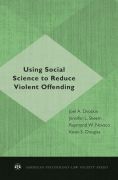
Using social science to reduce violent offending
Dvoskin, Joel A.
Skeem, Jennifer L.
Novaco, Raymond W.
Douglas, Kevin S.
Bringing together experts in the fields of social science, forensic psychology and criminal justice, Using Social Science to Reduce Violent Offending addresses what truly works in reducing violent offending, promoting an approach tocorrectional policy grounded in an evidence-based and nuanced understanding of human behaviour. Over the past three decades, the American criminal justice system has become unapologetically punitive. High rates of incarceration and frequent use of long-term segregation have become commonplace, with little concern for evidence that such practices make the public safer - and as the editors of this groundbreaking volume assert, they do not.Bringing together experts in the fields of social science, forensic psychology and criminal justice, Using Social Science to Reduce Violent Offending addresses what truly works in reducing violent offending. Promoting an approach to correctional policy grounded in an evidence-based and nuanced understanding ofhuman behavior, leading authorities from the United States, Canada, and GreatBritain offer specific and practical strategies for improving the criminal and juvenilejustice systems. Beginning by covering the history and scope of violent crimeand incarceration in the U.S., this pioneering volume offers clear and practical recommendations for implementing approaches focused on behavioral change of even the most particular offender groups, such as juvenile offenders, sexualoffenders,and offenders with mental illnesses. The authors argue for a more scientifically informed justice system, one where offenders-through correctional approaches such as community-based treatments and cognitive behavioral interventions-can be expected to learn the skills they will need to succeed in avoiding crimeupon release. Authors also highlight methods for overcoming system inertia inorder to implement these recommendations. Drawing on the science of human behavior to inform correctionalpractice, this book is an invaluable resource for policymakers, practitioners, mental health and criminal justice professionals, and anyone interested in the science behind the policies surrounding criminal punishment. Series ForewordPrefaceContributorsPart I. Defining the Problem: Crime, Incarceration, and Recidivism in the U.S.Chapter 1. Crime and rates of incarceration in the U.S.Alfred BlumsteinChapter 2. A short history of corrections: The rise, fall, and resurrection of rehabilitation through treatmentClive R. HollinPart II. Targeting Contextual Contributors to the ProblemChapter 3. Contextual Influences on ViolenceDavid P. FarringtonChapter 4. The good, the bad, and the ugly of electronic mediaMuniba Saleem and Craig A. AndersonChapter 5. Public attitudes and punitive policiesTom R. Tyler and Lindsay E. RankinPart III. Improving Our Approach to Individual OffendersChapter 6. The Risk-Need-Responsivity (RNR) Model of Correctional Assessment and TreatmentDonald AndrewsChapter 7. Assessment and Treatment Strategies for Correctional InstitutionsPaul Gendreau and Paula SmithChapter 8. Putting Science to Work: How the Principles of Risk, Responsivity and Need Apply to ReentrySusan Turner and Joan PetersiliaChapter 9. Reducing recidivism and violence among offending youthBarbara Oudekerk and Dickon ReppucciChapter 10. Extending rehabilitative principles to violent sex offendersJudith V. Becker and Jill D. StinsonChapter 11. Extending violence reduction principles to justice-involved persons with mental illnessJohn Monahan and Henry J. SteadmanPart IV. A Way ForwardChapter 12. Addressing system inertia to effect changeJames McGuireChapter 13. What if psychology redesigned the criminal justice system? (Editors)Joel A. Dvoskin, Jennifer L. Skeem, Raymond W. Novaco, and Kevin S. DouglasIndex
- ISBN: 978-0-19-538464-2
- Editorial: Oxford University
- Encuadernacion: Cartoné
- Páginas: 344
- Fecha Publicación: 29/09/2011
- Nº Volúmenes: 1
- Idioma: Inglés
